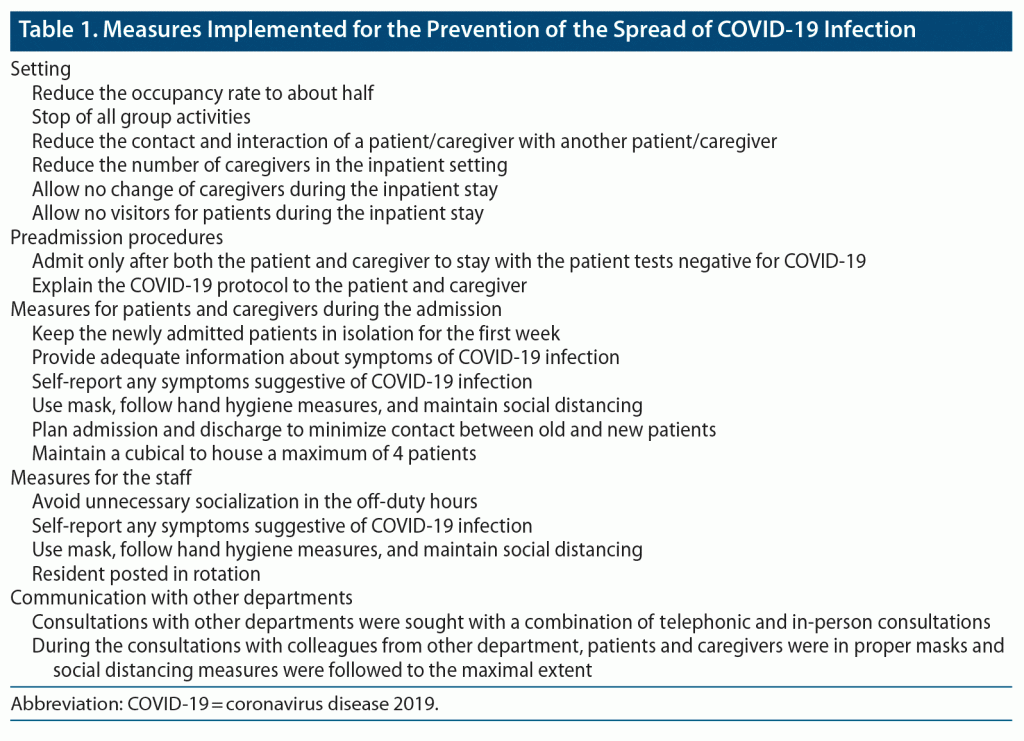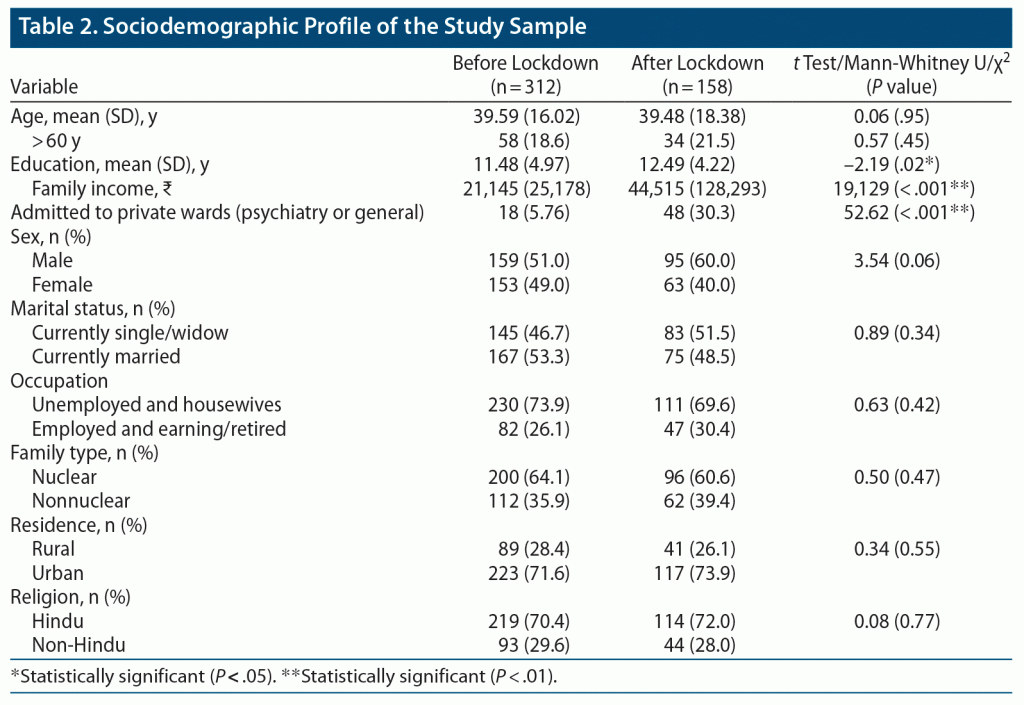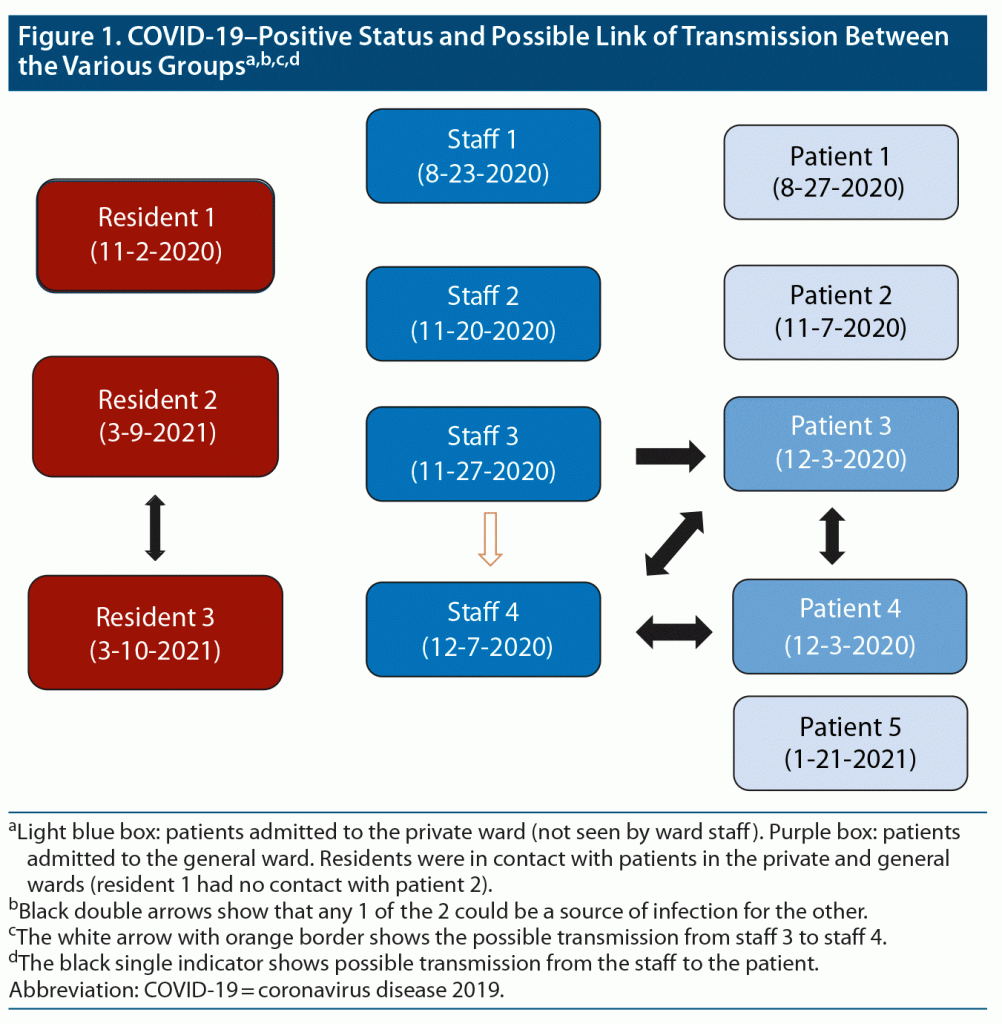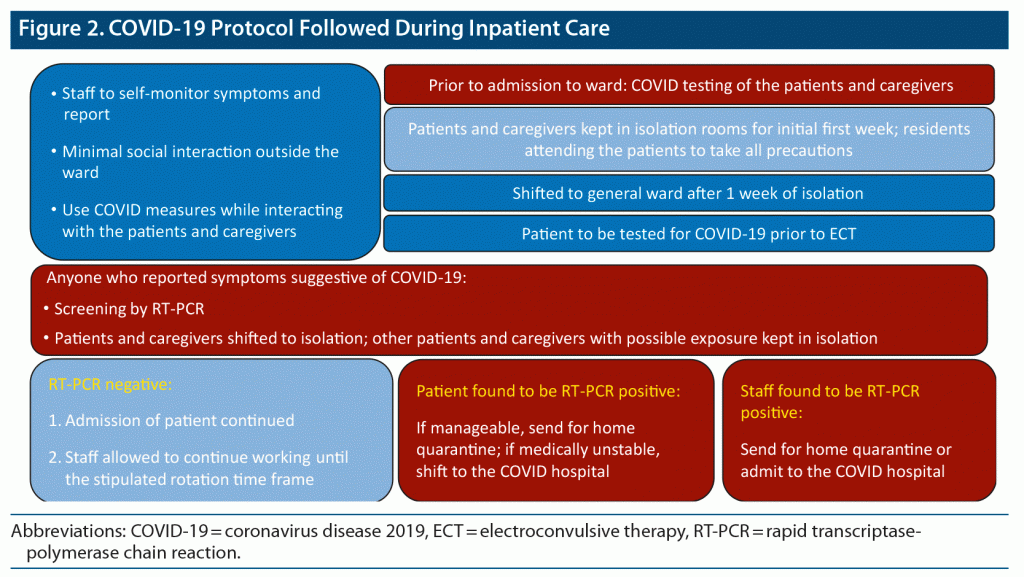ABSTRACT
Objective: To evaluate the demographic and clinical profiles of patients admitted to the psychiatry ward during the coronavirus disease 2019 (COVID-19) pandemic and compare with profiles of patients admitted 1 year before the onset of the pandemic (ie, before the lockdown announcement in India). An additional objective was to evaluate the incidence of COVID-19 infection in the psychiatry inpatient unit and discuss the measures taken to run the unit during the pandemic, including the measures taken if any patient or staff member was detected to have COVID-19 infection.
Methods: This retrospective study was conducted in a tertiary care hospital in North India. Data of patients admitted to the inpatient unit from March 24, 2019, to March 23, 2020, were compared with data from March 24, 2020, to March 23, 2021. The data were extracted from the inpatient registry.
Results: Compared to the pre-pandemic period, fewer patients were admitted during the pandemic, and the patients admitted had more severe illness. During the ongoing pandemic, the incidence of COVID-19 infection among the residents was 5%, nursing staff was 4.7%, and support staff was 6.66%. The incidence rate of COVID-19 among the patients was 3.2%. Patients were not found to be the primary source of infection; on the other hand, COVID-positive status among the health care professionals was responsible for patients becoming infected.
Conclusions: During the ongoing COVID-19 pandemic, psychiatry inpatient facility can be managed with reduced capacity and by following COVD-19 protocol.
Prim Care Companion CNS Disord 2021;23(6):21m03021
To cite: Grover S, Chakrabarti S, Chakraborty R, et al. Management of a psychiatry inpatient unit during the COVID-19 pandemic: an audit of services. Prim Care Companion CNS Disord. 2021;23(6):21m03021.
To share: https://doi.org/10.4088/PCC.21m03021
© Copyright 2021 Physicians Postgraduate Press, Inc.
aDepartment of Psychiatry, Postgraduate Institute of Medical Education and Research, Chandigarh, India
*Corresponding author: Sandeep Grover, MD, Department of Psychiatry, Postgraduate Institute of Medical Education and Research, Chandigarh 160012, India ([email protected]).
The coronavirus disease 2019 (COVID-19) pandemic has greatly impacted mental health care services. At the beginning of the pandemic, outpatient services were stopped or reduced at institutions worldwide.1–4 A survey by the World Health Organization conducted from June to August 2020, which included data from 130 countries, suggested that the pandemic led to disruption or halting of mental health services in 93% of countries.5 In terms of vulnerable groups, the survey reported disruption of services for children and adolescents (72%), the elderly (70%), and women requiring antenatal or postnatal services (61%).5 In terms of interventions, counseling and psychotherapy services were disrupted in 67% of countries, critical harm reduction services were disrupted in 65% of countries, and opioid agonist maintenance treatment was disrupted in 45% of countries. Further, mental health services provided at the workplace (75%) and in schools (78%) were disrupted in about three-fourths of the countries. There was an expansion of teleservices in 70% of the countries, more so in developed nations.5 However, there are limited data on the impact of the pandemic on inpatient services. Studies from different parts of the world suggest that psychiatry wards were closed and converted to COVID wards to accommodate patients with infection.6,7 However, at some institutions, separate wards were created for COVID-positive patients with mental illnesses.6,7 Throughout the world, inpatient units followed different COVID-related protocols, which included use of masks, social distancing, and frequent hand washing.6–9 Additionally, some centers used teleservices in the inpatient setting to minimize patient contact with health care services.10,11
In India, most mental health services were impacted, in both the institutional setting3 and the private sector.12 However, little is known about running inpatient services during the ongoing pandemic. It is essential to understand the impact of the pandemic on inpatient services and the factors that disrupt services in settings with limited resources. An improvement in this understanding can help in reorganization to minimize disruption of ongoing services in the wake of the second wave of COVID-19 in India. Accordingly, this study aimed to evaluate the demographic and clinical profiles of patients admitted to the psychiatry ward during the COVID-19 pandemic and compare with profiles of patients admitted 1 year before onset of the pandemic (ie, before the lockdown announcement in India). The study also aimed to document the incidence of COVID-19 infection in the psychiatry inpatient unit and describe the COVID-related measures taken in the units, including when patients or staff received a positive diagnosis.
METHODS
This retrospective study was conducted in a tertiary care hospital in North India. The ethics committee of the hospital approved the study. The Department of Psychiatry has 27 general beds and 2 private rooms in the psychiatry ward. Of the 27 beds in the general ward, 6 are used for rapid turnover (ie, the patients admitted to these beds are usually discharged within 2 weeks of admission). The rest of the beds are used for routine care. Patients are generally admitted for 2 weeks to up to 3 months, with an occasional patient admitted for a longer duration. Rarely, patients are admitted to the general private ward of the hospital. Most of the admissions occur from outpatient services. During the entire period of admission, patients are required to be accompanied by 1 to 2 caregivers, mostly family members. Each morning, group ward activities include prayers, exercising, and a few recreational activities. The general ward comprises 4 cubicles, each of which can accommodate 6 patients. Additionally, there are 4 isolation rooms that are used for 1 to 2 patients, depending on the need.
With the onset of the COVID-19 pandemic, the inpatient facility was reduced to 15 routine beds in the general ward, with no rapid turnover beds. The private wards attached to the psychiatry ward were closed; however, the private wards in the general units of the hospital were available for patients with mental illness. In-person outpatient services were suspended from March 19 to October 31, 2020, and telepsychiatry services were started in mid-April 2020. The emergency services and consultation-liaison psychiatry services continued as before the pandemic. The electroconvulsive therapy (ECT) service was limited to inpatients only, and ECT on an outpatient basis was suspended for some time. Patients receiving ECT underwent rapid transcriptase-polymerase chain reaction (RT-PCR) testing prior to administration of the first ECT session from April to August 2020. Later, from September 2020, patients receiving ECT had to undergo RT-PCR testing before each ECT session, and ECT services were resumed for outpatients.
With the announcement of lockdown in India and reduction in the number of inpatient beds, COVID-19 protocols were implemented for patients, their caregivers, and staff (Table 1), as per the latest recommendations.13 Patients were admitted after they and their caregivers tested negative on the RT-PCR test. The number of caregivers accompanying each patient was reduced to 1, except for violent and aggressive patients who were allowed to have 2 caregivers. During the first week of admission, patients and their caregivers were kept in the isolation room. If they did not report any symptoms suggestive of COVID-19 infection during this period, they were shifted to the cubicles, which could accommodate a maximum of 4 patients.
The caregivers and patients were asked to use a mask during their inpatient stay, maintain social distancing, frequently wash their hands and use hand sanitizer. Additionally, the caregivers were instructed to minimize their movement out of the ward. Interactions among the patients and caregivers were restricted, with social distancing and use of a mask. Group ward activities were canceled.
The trainee residents were posted on a rotation basis for 2–4 weeks from April to December 2020. From January 2021, the posting of residents could extend for a longer duration. The residents were also encouraged to follow the COVID-19–related precautions while working on the inpatient unit. Other staff (nursing staff and hospital attendants) were also encouraged to follow the COVID-19–related precautions.
Everyone was encouraged to report symptoms suggestive of COVID-19 infection, and whenever anyone disclosed symptoms, they were evaluated as per the institutional protocol. No structural changes were made in the psychiatry ward area, except that the main entry of the psychiatry ward was closed, and the emergency exit was used for entry and exit.
The basic data for inpatients are coded in the ward register, and the same data are maintained in SPSS format. The essential data include demographic profile, diagnosis, investigations conducted, and management during the inpatient stay. These data are coded on a day-to-day basis and reviewed periodically for completeness and accuracy. After the pandemic began, a record of COVID-19 positivity among patients and staff was also kept.
For this study, the data of patients admitted to the inpatient unit from March 24, 2019, to March 23, 2020, were compared with data from March 24, 2020, to March 23, 2021. The data were extracted from the inpatient registry.
RESULTS
As is evident from Table 2, there was a significant reduction (49.4%) in the number of patients admitted to the psychiatry inpatient unit when the data from before and after declaration of lockdown were compared. Patients admitted during the pandemic had significantly higher incomes, were more educated, and were more often admitted to the general private wards compared to the pre-pandemic year (see Table 2).
During the pandemic period, lower proportions of patients were admitted for special treatment (ie, ECT or any kind of psychological treatment), on an urgent basis, or with obsessive-compulsive disorder. Those admitted during the pandemic had a higher number of previous admissions, more often received ECT, and were more often admitted more than once during the period of evaluation (Table 3). Also, a higher proportion of patients at the time of discharge were prescribed benzodiazepines, other medications, and continuation/maintenance ECT during the COVID period.
COVID Positivity
During the COVID period, at admission, only 4 patients or their caregivers tested positive for COVID-19 and thus could not be admitted. During the inpatient stay, only 1 patient developed severe respiratory symptoms and had to be shifted out of the ward for further evaluation for COVID-19. However, the patient was later found to not have COVID-19, but rather had a pulmonary embolism. This patient’s ECT was continued after management of the pulmonary embolism.
During the pandemic, 3 (5%) residents (of 59 junior and senior residents), 3 (4.7%) nursing staff/students (of 14 nursing staff and 50 nursing students), and 1 (6.66%) support staff member (of 15) who worked in the ward were found to be positive for COVID-19. Among all residents and staff who tested positive, the source of infection was traced to interaction of the staff or resident with people outside the ward or with coworkers in the ward. Patients were never found to be the primary source of infection in any incidence.
During the 1-year COVID period, of 158 patients admitted, 5 (3.2%) tested positive for COVID-19. All the patients who tested positive for COVID-19 were receiving ECT and were undergoing regular COVID-19 testing. Among the patients who tested positive, 3 were admitted to a private room and 2 were admitted to the general ward (Figure 1). Those admitted to the private ward allowed their relatives to visit them, despite being instructed not to do so, which contributed to the possible infection. Staff members were considered the source of infection of patients admitted to the general ward (Figure 1). When a patient tested positive, after initial surveillance of 1 week, all patients in the psychiatry ward underwent testing, and on no occasion were any additional patients detected to have COVID-19 infection.
When a patient tested positive, the junior resident taking care of the patient was quarantined, and all patients seen by the resident were isolated and monitored or were given an option of home quarantine. During the subsequent testing, none of these patients tested positive. When a resident tested positive, they also were offered admission to the COVID ward or home quarantine. Patients who had been seen by the resident were kept in isolation in the ward or were given the option for home quarantine and were tested after 5 days. None of the patients tested positive (Figure 2).
When a patient, resident, or nursing or support staff member tested positive, interactions between the staff, the patients, and caregivers were minimized; all were asked to monitor their symptoms and report such symptoms as soon as possible. None of the patients or the other staff became positive during the subsequent monitoring periods, except for possible transmission of infection from 1 nursing staff member to another (Figure 1). Only on 1 occasion did we encounter transmission from 1 person to another in the ward (Figure 1).
Throughout the 1-year period, when 2 residents tested positive together, the ward resident team was changed completely, and ECT services were suspended for 1 week. When any patient or staff member, including residents, tested positive, new admissions were temporarily stopped in the psychiatry ward for 5 days. There was no mortality among any of the individuals who tested positive for COVID-19 infection during the COVID study period.
Frequency of Problematic Behaviors and Anger Among Inpatients During the Pandemic Period
With respect to COVID-19 precautions, 41.2% (n = 63) of the patients were annoyed with the restrictions. Very few patients (n = 8) required physical restraints during their inpatient stay.
DISCUSSION
The present study shows no change in the demographic profiles of patients admitted to the psychiatry inpatient unit pre- and post-pandemic, except that patients admitted during the COVID period were more educated and had higher family incomes. The higher family income of the patients admitted during the COVID period could be due to an increase in the percentage of patients admitted to the private wards. This profile could also be an indicator that patients with lower incomes could not reach the hospital and hence were not admitted. The patients admitted during the pandemic had a higher number of previous admissions, and a higher proportion of the patients received ECT and had multiple admissions. These findings possibly reflect that only those patients who could not be managed without ECT were admitted during the pandemic. These findings also suggest the need to continue ECT services for severely ill patients, as has been recommended previously.14–18 A higher proportion of patients admitted during the COVID period requiring ECT also possibly reflects that these patients were more severely ill and experienced frequent relapses. Also, a higher proportion of patients admitted during the COVID period were on benzodiazepines, other medications, and continuation/maintenance ECT at the time of discharge. These factors also possibly reflect the higher severity of illness of patients admitted during the pandemic. All these findings reflect that only severely ill patients were admitted to optimally utilize the reduced services during the pandemic.
In terms of the reason for admission, there was a decrease in the number of patients admitted for special treatment and those requiring urgent admission. The reduction in the number of patients requiring acute admission could be attributed to the closure of the rapid beds, which were being used previously for short stays, and the management of patients requiring urgent admission. A reduction in the number of patients requiring admission for special therapy and that for obsessive-compulsive disorder could be attributed to the possible reluctance of patients with this disorder to visit the hospital due to fear of infection, as has been reported previously.19–21 Additionally, this could also be due to reluctance on the part of the treatment team to admit such patients given the ongoing pandemic.
Despite all this, our COVID-19 positivity rate was only 3.2% for patients, 5% for residents, 4.7% for nursing staff and students, and 6.66% for support staff. In most cases, the residents and staff were infected from sources other than the patients. The results showed that more positive cases were detected during the latter part of the year, suggesting complacency or carelessness over time. Also, of the 12 individuals with COVID-19–positive status, 3 were detected at the beginning of the second wave of COVID-19 in India. This finding suggests that, to run a psychiatry inpatient unit successfully during the pandemic, COVID-19 safety precautions must consistently be followed. The results indicate that a cluster of COVID-19 cases were avoided because immediate action was taken to stop further spread by imposing isolation and offering home quarantine to patients and staff. Our findings also suggest that if proper measures are implemented for staff and patients, the spread of infection in the inpatient unit from one person another can be prevented without complete closure of services, as has been reported from different parts of the world.6,9,22 In our setting, precautions that possibly helped to maintain the low COVID-19 incidence rate were following COVID-19 protocols, having isolation wards to segregate the patients during the initial part of the admission, isolating patients and caregivers if someone was detected to have COVID-19 infection, and moving patients diagnosed with COVID-19 to their homes. The other finding was that patients who were admitted in the general private ward, away from the main psychiatry ward, had poor compliance with the COVID-19 protocol. This poor compliance could have been due to poor supervision of these patients by the psychiatry team throughout the day. Hence, it can be said that there is a need to develop a strategy to improve the compliance of the patients and their caregivers admitted to the private wards away from the main psychiatry ward. The present study has several limitations, including the retrospective study design and the inclusion of a limited number of clinical variables.
To conclude, our study suggests that the COVID-19 pandemic has led to the admission of only severely ill patients. Further, the results indicate that an inpatient facility can be managed successfully during the ongoing pandemic if the proper precautions are taken to maintain social distancing, hand hygiene measures, and adequate use of masks. Additionally, if appropriate safety measures are employed for the staff and patients, then the spread of infection in the inpatient psychiatric units can be prevented without complete closure of services.
Submitted: May 23, 2021; accepted August 20, 2021.
Published online: December 2, 2021.
Potential conflicts of interest: None.
Funding/support: None.
Clinical Points
- Inpatient psychiatry units can be effectively managed during the COVID-19 pandemic by developing proper protocols for patients and staff that can be tailored according to the available infrastructures and prevailing situations.
- If appropriate COVID-19 behavior and protocols are followed, then the chances of spreading COVID-19 infection are minimal.
- There is a need to develop universal COVID-19 guidelines for psychiatric inpatient unit management to prevent closure of psychiatric wards.
References (22)

- Bojdani E, Rajagopalan A, Chen A, et al. COVID-19 pandemic: impact on psychiatric care in the United States. Psychiatry Res. 2020;289:113069. PubMed CrossRef
- D’Agostino A, Demartini B, Cavallotti S, et al. Mental health services in Italy during the COVID-19 outbreak. Lancet Psychiatry. 2020;7(5):385–387. PubMed CrossRef
- Grover S, Mehra A, Sahoo S, et al. State of mental health services in various training centers in India during the lockdown and COVID-19 pandemic. Indian J Psychiatry. 2020;62(4):363–369. PubMed CrossRef
- Thome J, Coogan AN, Fischer M, et al. Challenges for mental health services during the 2020 COVID-19 outbreak in Germany. Psychiatry Clin Neurosci. 2020;74(7):407. PubMed CrossRef
- COVID-19 disrupting mental health services in most countries, WHO survey. World Health Organization. 2020. Accessed April 18, 2021. https://www.who.int/news/item/05-10-2020-covid-19-disrupting-mental-health-services-in-most-countries-who-survey
- Knowles M, Aref-Adib G, Moslehi S, et al. Containing COVID: the establishment and management of a COVID-19 ward in an adult psychiatric hospital. BJPsych Open. 2020;6(6):e140. PubMed CrossRef
- Ma J, Zhong H, Jiang M, et al. Emergency response strategy for containing COVID-19 within a psychiatric specialty hospital in the epicenter of the COVID-19 epidemic in China. Transl Psychiatry. 2020;10(1):268. PubMed CrossRef
- Li W, Yang Y, Liu Z-H, et al. Progression of mental health services during the COVID-19 outbreak in China. Int J Biol Sci. 2020;16(10):1732–1738. PubMed CrossRef
- Yang M, Wang H, Li Z, et al. Prevention and control of COVID-19 infection in a Chinese mental health center. Front Med (Lausanne). 2020;7:356. PubMed CrossRef
- Corruble E. A viewpoint from Paris on the COVID-19 pandemic: a necessary turn to telepsychiatry. J Clin Psychiatry. 2020;81(3):20com13361. PubMed CrossRef
- Xiang Y-T, Zhao Y-J, Liu Z-H, et al. The COVID-19 outbreak and psychiatric hospitals in China: managing challenges through mental health service reform. Int J Biol Sci. 2020;16(10):1741–1744. PubMed CrossRef
- Grover S, Mehra A, Sahoo S, et al. Impact of COVID-19 pandemic and lockdown on the state of mental health services in the private sector in India. Indian J Psychiatry. 2020;62(5):488–493. PubMed CrossRef
- Grover S, Sahoo S, Mehra A. How to organize mental health services in the era of unlockdown. Indian J Psychol Med. 2020;42(5):473–477. PubMed CrossRef
- Bellini H, Cretaz E, Rigonatti LF, et al. Electroconvulsive therapy practice during the COVID-19 pandemic. Clinics (São Paulo). 2020;75:e2056. PubMed CrossRef
- Boland X, Dratcu L. Electroconvulsive therapy and COVID-19 in acute inpatient psychiatry: more than clinical issues alone. J ECT. 2020;36(3):223–224. PubMed CrossRef
- Grover S, Sinha P, Sahoo S, et al. Electroconvulsive therapy during the COVID-19 pandemic. Indian J Psychiatry. 2020;62(5):582–584. PubMed CrossRef
- Sienaert P, Lambrichts S, Popleu L, et al. Electroconvulsive therapy during COVID-19-times: our patients cannot wait. Am J Geriatr Psychiatry. 2020;28(7):772–775. PubMed CrossRef
- Tor PC, Phu AHH, Koh DSH, et al. Electroconvulsive therapy in a time of coronavirus disease. J ECT. 2020;36(2):80–85. PubMed CrossRef
- Kuckertz JM, Van Kirk N, Alperovitz D, et al. Ahead of the curve: responses from patients in treatment for obsessive-compulsive disorder to coronavirus disease 2019. Front Psychol. 2020;11:572153. PubMed CrossRef
- Sahoo S, Bharadwaj S, Mehra A, et al. COVID-19 as a “nightmare” for persons with obsessive-compulsive disorder: a case report from India. J Ment Health Hum Behav. 2020;25(2):146–148. CrossRef
- Seçer İ, Ulaş S. An investigation of the effect of COVID-19 on OCD in youth in the context of emotional reactivity, experiential avoidance, depression and anxiety. Int J Ment Health Addict. 2020;1–14. PubMed
- Billings J, Greene T, Kember T, et al. Supporting hospital staff during COVID-19: early interventions. Occup Med (Lond). 2020;70(5):327–329. PubMed CrossRef
Enjoy free PDF downloads as part of your membership!
Save
Cite
Advertisement
GAM ID: sidebar-top









